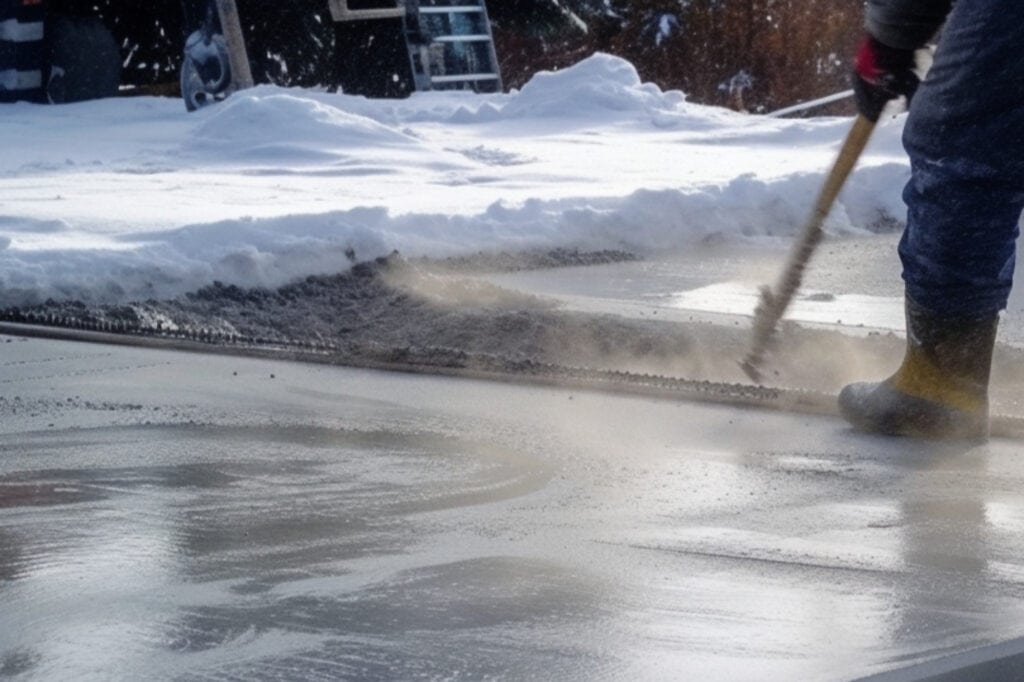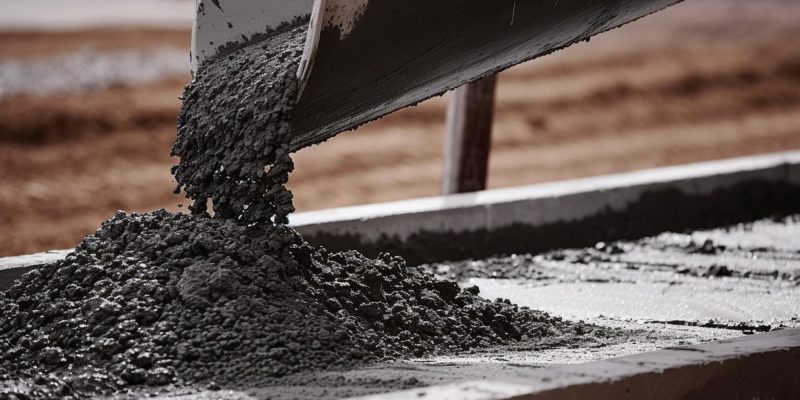Are you planning to pour concrete for your next home project? Well, you’re in the right place. This blog post will guide you through the best temperatures for concrete pouring, ensuring your project stands the test of time, no matter the season. Let’s dive into the concrete world together, making your next project a smashing success!
Understanding Concrete
Concrete is more than just a mix of water, cement, and aggregate; it’s a versatile building material that has been supporting structures worldwide for centuries. To truly appreciate the art and science of concrete pouring, starting with the basics is essential.
Basics of Concrete Composition
At its core, concrete consists of three main components:
- Cement: The “glue” of the mix, cement combines with water to start the chemical reaction known as hydration. This process binds the materials together, forming a durable matrix that hardens over time.
- Aggregate: Made up of sand, gravel, or other coarse materials, aggregate gives concrete its volume and strength. The choice of aggregate can affect the concrete’s properties, such as its weight, thermal performance, and durability.
- Water: Water initiates the chemical reaction with cement, allowing the concrete to set and harden. The amount of water is crucial; too much can weaken the concrete, while too little can prevent it from setting correctly.
The right mix can be poured into almost any shape and size, adapting to the needs of various projects…
Understanding the role of each ingredient reveals why concrete is so dependable and versatile. The right mix can be poured into almost any shape and size, adapting to the needs of various projects, from driveways to foundations.
How Temperature Affects Concrete Curing
Curing is the process that occurs after concrete is poured, involving the ongoing hydration of cement. This stage is vital for the development of concrete’s strength and durability. Temperature directly impacts curing, influencing the speed and effectiveness of the hydration reaction.
In Warm Conditions
Heat accelerates hydration, causing the concrete to set faster. While this might seem advantageous, it can lead to problems such as rapid moisture loss and uneven curing, resulting in surface cracks and weak spots.
In Cold Conditions
Cold temperatures slow down the hydration process. If the water in the concrete mix freezes, the expansion can create internal cracks and compromise the concrete’s integrity. Properly curing in cold weather often requires additional measures to protect and maintain the concrete at a consistent temperature.
The interplay between temperature and curing underscores the need for careful planning and execution in concrete projects. The goal is to maintain optimal conditions throughout the curing period, ensuring the concrete achieves its maximum strength and longevity.
Temperature Guidelines for Pouring Concrete in Any Weather
Knowing the right temperature for concrete pouring is pivotal for the material’s longevity and structural integrity. Let’s break down the guidelines and factors influencing how and when to pour concrete.
General Temperature Guidelines
The optimal temperature range for pouring concrete is between 50°F and 90°F. Within this range, the hydration reaction proceeds at a pace that allows adequate strength development without the risk of rapid drying or freezing. This temperature range is beneficial in places where the weather can vary through the seasons.
Factors Influencing Temperature
Several environmental factors can affect these temperature guidelines, making it important to consider more than just the thermometer reading:
- Humidity: High humidity levels can slow water evaporation from the concrete surface, extending the curing time and reducing the risk of cracking. Conversely, low humidity can speed up evaporation, potentially leading to rapid moisture loss and surface cracking if not properly managed.
- Wind Speed: Wind can significantly increase the evaporation rate from the concrete surface, especially on hot days. Windbreaks or applying a water-retaining curing compound can help manage this effect.
- Concrete Mix: The specific composition of your concrete mix can also influence the optimal pouring temperature. Mixes with certain admixtures or supplementary cementitious materials may be more forgiving in extreme temperatures or even designed specifically for such conditions.
- Sun Exposure: Direct sunlight can heat the concrete surface and accelerate water evaporation. In hot weather, scheduling pours early in the morning can mitigate the impact of sun exposure.
Adjusting for these factors is crucial for ensuring the successful curing of concrete. By understanding and applying these temperature guidelines, homeowners can significantly improve the outcome of their concrete projects.
Best Temp for Pouring in Cold Weather
Pouring concrete in cold weather brings unique challenges, but with the proper preparation and techniques, these obstacles can be successfully navigated. Let’s explore how to achieve the best results when temperatures drop.
Challenges of Cold Weather Concreting
Cold weather concreting can be tricky due to the risk of the concrete mix freezing before it has a chance to properly cure. When temperatures dip below 32°F, the water in the concrete can freeze, expanding and creating internal cracks that compromise the structural integrity of the hardened concrete. Additionally, the hydration process slows down in cold weather, which can delay setting times and strength development.
Strategies for Success
To ensure successful concrete pouring in cold weather, consider the following strategies:
- Use Heated Water or Additives: Mixing your concrete with heated water or using chemical additives can help prevent freezing and ensure the hydration process continues effectively.
- Insulate the Pouring Area: Cover the concrete with insulating blankets or a tarp to retain heat after pouring. This helps maintain a consistent temperature, allowing the concrete to cure correctly.
- Plan for a Longer Curing Time: Be prepared for the curing process to take longer in cold weather. Protecting the concrete from freezing for at least the first 24 to 48 hours after pouring is vital.

It is important to note that the ideal temperature for concrete pouring in cold weather is between 50-60 degrees Fahrenheit. By following these guidelines and pouring concrete within this temperature range, you can ensure that your project is not delayed by the onset of colder weather.
Best Temp for Pouring in Hot Weather
Conversely, pouring concrete in hot weather presents a different set of challenges, primarily related to the rapid evaporation of water from the mix. Here’s how to manage concrete pouring when the mercury rises.
Challenges of Hot Weather Concreting
High temperatures, direct sunlight, and wind can lead to rapid water evaporation from the concrete surface, which can cause cracking and weaken the concrete. Hot weather can also accelerate the curing process, reducing the workable time to smooth and finish the concrete.
Cooling Strategies
To combat the challenges of hot weather concreting, employ the following tactics:
- Cool the Ingredients: Use chilled water or ice to mix your concrete, and keep the aggregate in the shade before mixing. This helps lower the overall temperature of the concrete mix.
- Moist Cure: Keeping the concrete surface moist can prevent rapid evaporation. This can be achieved through regular watering or by covering the concrete with wet burlap or a curing blanket.
- Schedule Wisely: Pouring in the early morning or late evening can avoid the peak temperatures and reduce the impact of sun exposure.
RECOMMENDATION
To achieve optimal strength and durability, it is recommended that concrete pouring should be carried out in temperatures between 70-80 degrees Fahrenheit during hotter months in Des Moines. These strategies will help ensure that concrete poured during this temperature range has the best chance of curing correctly.
Challenges in Concrete Pouring in Any Weather
Regardless of the season, pouring concrete requires adaptability and careful planning. Here are key considerations for managing concrete projects in any weather condition.
Adapting to Extreme Conditions
Being prepared for sudden weather changes is crucial. This means having the flexibility to delay pouring if extreme weather is forecasted and knowing how to adjust your concrete mix and curing techniques to suit the current conditions.
Importance of Planning and Flexibility
A successful concrete project involves more than just watching the weather; it requires understanding how different conditions affect the concrete’s behavior. This might include adjusting schedules to find the most suitable weather window or modifying the project’s scope based on forecasted conditions.
Tips for Successful Concrete Pouring
Finally, ensuring the success of your concrete project boils down to preparation, monitoring, and care.
Pre-Pour Preparation
Select the right concrete mix for your specific project needs and thoroughly inspect the site beforehand. Ensure forms are properly secured and you have all the necessary tools and materials.
Monitoring and Post-Pour Care
Keep a close eye on the weather and the concrete’s condition as it cures. Protecting the concrete from extreme conditions during this critical phase is key to achieving a durable finish.
Leveraging Technology
Modern technology, from weather apps to concrete moisture and temperature sensors, can provide valuable insights and help guide your decisions throughout the pouring and curing process.
Conclusion
Concrete pouring requires understanding how different temperatures and weather conditions affect the material. By following the guidelines and tips outlined in this blog post, homeowners can navigate the challenges of cold and hot weather, ensuring their concrete projects are successful and stand the test of time. Remember, a little planning goes a long way in achieving the perfect pour.
Frequently Asked Questions
What is the ideal temperature for fresh concrete?
The ideal temperature for fresh concrete to ensure optimal curing and strength development is between 50°F and 60°F (10°C to 15°C). This temperature range supports the chemical reactions necessary for the concrete to cure correctly, allowing it to achieve its intended durability and structural integrity.
What is the maximum allowed concrete temperature during pouring on site?
The maximum allowed temperature for concrete during pouring on site is generally 90°F (32°C). Exceeding this temperature can accelerate the curing process too much, leading to potential problems such as rapid water loss, cracking, and decreased overall strength of the concrete.
Why is the temperature in pouring concrete important?
The temperature in pouring concrete is crucial because it directly affects the curing process, which determines the strength and durability of the concrete. Proper temperature management ensures the concrete cures at a rate that allows it to develop the necessary internal structure to support loads and resist environmental stresses. Inappropriate temperatures can lead to weak concrete, surface cracks, and other defects that compromise the longevity and safety of the structure.

